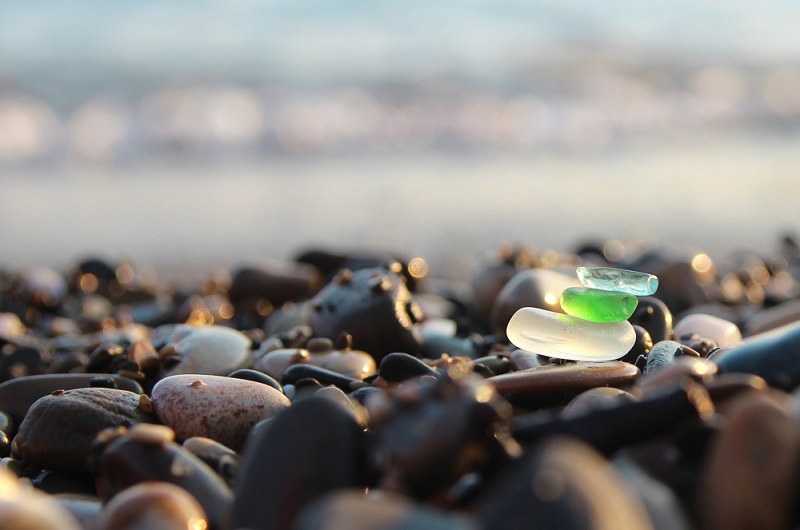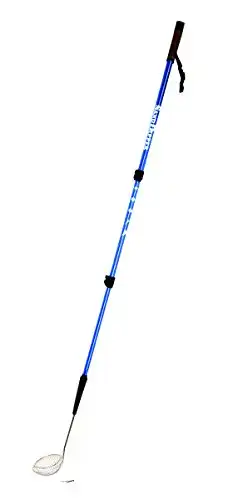Welcome to the fun and exciting hobby of sea glass hunting. If you’re only just learning about sea glass, you’re in for an interesting and colorful adventure.
Collecting sea glass has become especially popular over the last 20 years or so. Many have come to appreciate the historical and environmental significance of these unique pieces.
You may have heard this kind of collectible glass referred to as either sea glass or beach glass. While some may use the terms interchangeably, there is an important difference in the eyes of most treasure hunters. Sea glass in found along saltwater shores, while beach glass is found on freshwater beaches, especially along large lakes.
Read More:
- What Is Sea Glass And How Is It Formed?
- 9 Different Things To Do With Sea Glass! (How To Display Sea Glass)
- 10 Best Sea Glass Beaches on The East Coast

Sea glass is formed from glass containers that have been dumped at sea or washed out from the shore. This glass is broken up and tumbled by waves, sand, and rock for an average of 20-50 years until the edges have been smoothed away and the saltwater has left a frosty, smooth patina.
With the advent of stricter laws against littering, expanding recycling practices, and a large changeover to plastic from traditional glass containers, sea glass is slowly becoming rarer and more valuable to collect, so the time to start is now.
When you are ready to go sea glass hunting, there are a few important things to remember. There are a few beaches, such as Fort Bragg Beach in California and Glass Beach in Kauai, Hawaii, where sea glass is abundant to look at but no collecting is allowed. Check out any similar restrictions in popular sea glass hunting areas near you.
Areas near cities, industrial, or commercial areas are preferable, as these areas have generally done more glass dumping in past years. The older the industry, the greater chances of finding older, more high-quality pieces.
There are also some helpful items to consider taking on your sea glass hunting expedition:
- Wide-brimmed hat
- Small rake or kitty litter scoop (I recommend the Sand Dipper available on Amazon)
- Sturdy shoes for climbing embankments or walking in rocky areas
Also, keep in mind that in the same areas where you find sea glass, you may also find:
- Polished bits of shells
- Hag stones
- Sea polished agate or jasper
- Other interesting specimens
This tool isn't for everyone. I'm listing it here for those who just aren't able to reach down and pick things up off the ground as easy as before. So, if you spend much time beachcombing, then you'll want to give this one a try. It's well worth it.
- Great for those with trouble bending down to pick up items.
- Access Hard To Reach Spots
- Stay Dry
- Doubles as a Walking Stick
10 Tips For Collecting Sea Glass
Here are some tips to make your search more successful. With a bit of planning and patience, you can see your collection of sea glass grow into something to brag about.
1. Types of beaches
Sea glass is generally more abundant on pebbly or rocky beaches. Don’t hesitate to wade out a few feet for a more thorough search, as tides allow.
If you are searching along a sandy shore, look for patches of pebbles that may hide glass. Remember that wet or white sand can easily disguise clear or white glass, so you’ll need to watch carefully.
Also, in pebbles and rocks, darker colors may look like the surrounding stones. Look for that familiar patina and hold dark pieces up to the sun. “Black” sea glass is actually dark green, brown or blue.
2. Watch the Tides
Low tide is the best time to go sea glass hunting. You can generally check tides in your hunting areas online. A full moon is another basic indicator of low tides.
It’s a good idea to search along both high and low tide lines. You can follow one line out and the other back, while continually scanning the area between.
3. Use the Sun
If possible, keep the sun at your back while searching for sea glass, or turn so the sun is behind to scan an area, looking for sparkly pieces. Sunglasses are a no-no for successful sea glass hunting, as they may change the appearance of the glass and hide its shine. A wide-brimmed hat is a much better choice for protecting your eyes.
4. Stowing Your Finds
Carry an old grocery bag or over-the-shoulder pouch to put new finds in. It can be easy to run out of pocket space if you come across a particularly abundant patch of glass. If you collect regularly, consider keeping any necessary items in your car for spur of the moment outings.
5. Take Your Time
Allow yourself several hours to peruse an area for sea glass. Don’t get in a rush. Enjoy the view, stop often to rest your neck and eyes, and scan several feet in front of you for any unusual colors or shapes.
By allowing plenty of time, your experience can be a relaxing, enjoyable one. Plan ahead to ensure you won’t feel pressured to hurry along.
6. Waves
Beaches with a more active surf are more likely to produce quality sea glass than calm, serene shorelines. If possible, drive along potential search areas beforehand to get an idea of where the waves come in more forcefully.
7. Storms
Storms are a sea glass collector’s friend. Try to take a walk after storms to discover what treasures new tidal surges may have brought in. Storms often push long-buried items into the light, so there’s a heightened possibility of finding older, higher-quality pieces or unusual colors along storm-tossed shores.
8. Private Property
Always be considerate of the rights of others. Don’t collect sea glass on private property without permission. Some beaches are simply off-limits to the general public.
If you are vacationing away from home or in another country, be aware that in some areas, sea glass is considered a part of local history. Taking pieces from these areas is considered a theft of local culture. Research before collecting in a new area in order to be aware of and respect local ideals and private citizens.
9. Keep the Cycle Moving
If you should pick up sea glass that still has sharp edges or shiny areas, throw these pieces as far out in the surf as possible. They can then continue to be tumbled into mature sea glass for future collectors.
10. Share the Experience
Collecting sea glass is not intended to be a competitive sport, although it can be fun to brag about special finds. Take a friend on your outing. You can enjoy the conversation as you hunt, or spread apart to expand your search.
Or if you meet other collectors along the way, enjoy sharing your finds along with tips and experiences. You may just make a new friend. There are also many social media sites where collectors share interesting historical information, spectacular treasures, or artisan sea glass creations.
Periodic sea glass hunting expeditions can become an enjoyable tradition between friends or family members. It’s not just about the glass, it’s about the connection between individuals and the earth home we share.
- 7 Of The Largest Gold Nuggets Ever Found…Ever! - December 21, 2023
- Find Gold On Your Property? Here’s Why You Should Think Twice Before Spreading the News - December 21, 2023
- The Opalized Crab Claw (And How It Formed) - September 14, 2023
- Online rock and mineral club for collectors of all levels!
- Find community with like-minded rock and mineral enthusiasts.
- Monthly Giveaways!
- Free Access to Entire Digital Library of Products (current and future products)*



